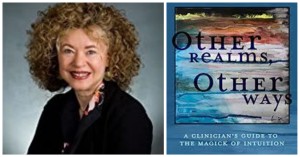National Association of Social Workers member Bette Freedson is a clinical social worker in South Berwick, Maine. She recently authored the book Other Realms, Other Ways: A Clinician’s Guide to the Magick of Intuition.”
We talked to Freedson about how social workers can incorporate intuition into their work with clients:
Q: You come from a background of psychic reading. What role did this play in your developing an interest in intuition?
Freedson: As I tell my readers in my new book before I was a social worker, I was a psychic.
I knew from the time I was very young that I had a gift. We all have this innate human capacity and potential. If we are motivated and see the benefits, intuition can be developed and applied in many dimensions of our lives, including social work practice.
I began doing “readings” a few years before going back to social work school after meeting Ramona Garcia, a well-known psychic, and spiritualist, who taught me how to pay attention to my intuition. Ramona and psychic and mentalist Herb Dewey, both of whom I mention in Other Realms, Other Ways, were my two most important teachers. Highly intuitive individuals, Herb and Ramona helped me develop my psychic skills with the understanding that I was not reading minds, not doing mental telepathy, but instead actually more typically “reading” my own intuitive knowing.
This idea intrigued me. I wanted to learn more, and my teachers were willing.
Both Ramona and Herb taught me how to pay attention to impressions that came to me while with a reading client. They explained that intuitive ideas and insights come in the form of images, teeny hunches and metaphors from which meaning could be derived. Like any skill, an intuitive way of accessing knowing takes practice, and I honed the skills via many readings, much investigation and many consultations with my teachers and other psychics.
 Herb Dewey trained me on delivering my intuitive knowing to a client, emphasizing that a reading should not be intended to predict pain, but only to uplift, to shore up strengths, to inspire change. In this way I was introduced to a social work value system well before becoming a social worker. I learned to do readings, not as entertainment( though a “reading” can definitely be fun) but as a form of counseling, a way of helping others.
Herb Dewey trained me on delivering my intuitive knowing to a client, emphasizing that a reading should not be intended to predict pain, but only to uplift, to shore up strengths, to inspire change. In this way I was introduced to a social work value system well before becoming a social worker. I learned to do readings, not as entertainment( though a “reading” can definitely be fun) but as a form of counseling, a way of helping others.
When later, I was in school at Boston University School of Social Work, learning about the profession, I began to see the way a social work value system was consistent with what I valued about my readings. I came to understand the importance of helping people seek the wisdom of their intuition in order to make more effective personal choices in their lives. Over the years I continue to experience the integral value of intuition – mine and the client’s – as guidance for partializing problems and choosing the most effective solutions.
This journey has been and continues to be exciting. Eventually, I would be teaching clients how to use their own intuition as a way of managing stress and coping with difficult life decisions. Now, I utilize an integrative intuitive approach in my practice, witnessing the way intuition guides my interventions while helping clients to access their own wise mind to more effectively attain their psycho-social-behavioral life goals.
In addition, I am now teaching other therapists how to use their own intuition for better psychosocial results. My book, Other Realms, Other Ways is a culmination of what I have learned up to this point (always more to come…) It is one of the ways I choose to share what I have learned and experienced with other social workers and helpers to access, cultivate, explore and utilize the gift.
Q: Why do people not trust their intuition?
Freedson: One possible reason people may not trust, partially trust, or only occasionally trust, their intuition is belief in a common misunderstanding about the nature of intuition itself. In the same way the word psychic can conjure negative distinctions, the word intuition, despite the fact that the act of intuiting is a natural way of knowing, may be subjectively misinterpreted as something bad, scary or even, sadly—evil. These misinterpretations, constructed by an individual’s subjective experiences are often maintained by consensus of a given socio-cultural group.
Another distinction about the nature of intuition that may engender an occasional lack of trust in its insights may be another subjectively created, and often non-conscious, belief that it is easier – or safer – to push aside intuitive knowing for fear that it may contain something upsetting. By developing a distrust of intuition based on fear of its accuracy, a paradox is created. For the lack of conscious trust, being based non-consciously, or partially consciously, on fear, actually suggests that intuition might be trust-worthy.
In actuality then, intuition is natural a human capacity, endowed by nature as part of our ability to think. Intuition is about accessing information through a non-rational (not irrational) way of knowing that involves both the mind, the body and the capacity to use inner sensing. Sometimes intuition happens so automatically that its wisdom goes unnoticed and unrealized.
Following is an excerpt from Other Realms, Other Ways about an experience I had at Boston University School of Social Work. This event may help to further explain the nature of intuition as different from more linear, algorithmic ways of gaining information.
“There I am, in the first row on the first day of my first, and thank goodness, my only statistics class. I’d been dreading the math-tech content of this course while at the same time relishing the psychosocial, socio-political, and clinical aspects of my MSW education. Specifically, I’d been nervous about the statistics reading list. However, when Professor Bruce Maloof passes out the syllabus, the first books are far from what I expect. My friend Margaret (who by the way does palm readings) is sitting next to me. We look at the paper and then wide eyed, at each other.
Zen and the Art of Motorcycle Maintenance? The Tao of Physics? And a couple books in the Carlos Castaneda series?
Evidently hearing his students’ unasked questions, Professor Maloof responds with a knowing chuckle. But in alluding to these atypical readings, he is quite serious, informing the class, “Lest you think that the scientific method is the only way to achieve knowledge, there is another way to know and to achieve wisdom. It is important for social workers to know about both ways.”
So, intuition, simply put, is another way of attaining knowledge. It is not a linear process, but rather an experience of knowing that puts together what you’ve known consciously, what you know non-consciously and what you just sense. Intuition presents through the mind – and the body – with images, hunches, somatic experiences and mini-ideas that just pop in. For example, intuitive knowing occurs with experiences called “clairsentience,” as when you have a feeling-sense that your best friend is about to call or text, and he does.
In Other Realms, Other Ways, I explain more fully the role of the five senses in intuitive knowing. For example, what is being conveyed by clammy hands, cold feet, butterflies in your stomach, when your heart “skips a beat,” or when you think about your favorite pizza and your mouth waters? Your body is an intuitive communicator. Paying attention can reveal wisdom
Intuitive wisdom offers benefits for social work practice. Eric Berne, known best for the book Games People Play also wrote a book entitled Intuition and Ego States. In this book he exhorts “psychologists” (this applies to social workers and other counselors) to use their intuition in the clinical context. In Other Realms, Other Ways, I present the ACE model for developing acceptance, cultivation and exploration of intuitive knowing.
Learning how to recognize and trust the unique ways your own intuition presents its information can take some dedication, motivation and practice. However, if you are willing to learn how to access, utilize and trust this amazing gift, you will find its benefits will enlighten and enhance your work and your life.
Q: When people say they see “Red Flags,” does this mean they are getting guidance from their intuition?
 Freedson: Often “red flag” is taken to mean a warning, which could certainly be intuitive guidance. A report of seeing a red flag or a flag of any color, might herald incoming intuitive guidance, or it may not. In many cases you might not realize the red flag was actually intuition until the warning reveals itself to have been real. In some instances, a red flag, or any colored flag, might be merely a thought and not necessarily an intuition. It takes practice to discern intuitive guidance from a random thought. Understanding and interpreting intuitive impressions can be made by the individual and sometimes can be aided by an intuitive consultation.
Freedson: Often “red flag” is taken to mean a warning, which could certainly be intuitive guidance. A report of seeing a red flag or a flag of any color, might herald incoming intuitive guidance, or it may not. In many cases you might not realize the red flag was actually intuition until the warning reveals itself to have been real. In some instances, a red flag, or any colored flag, might be merely a thought and not necessarily an intuition. It takes practice to discern intuitive guidance from a random thought. Understanding and interpreting intuitive impressions can be made by the individual and sometimes can be aided by an intuitive consultation.
Context and past experience can help you distinguish any thought, particularly a fearful “red flag” thought from an intuitive impression. Making these important distinctions takes practice. Knowing your personal triggers and life themes will help. As you go about the business of self-awareness, you will be better able to discern which inner messages are intuitive and whether to color them red, or some other color.
For example, I have a yellow flag for thunderstorms. Many years ago, a bolt of lightning came into my office and burned out my voice message recording device.
There was no other damage, but this storm ruined my denial that lightning would never come close to me. Since that time thunder and lightning storms bring up my anxiety. To determine if it is a yellow flag worry—or a red flag warning, I do a reality check. If no storms are predicted, I assume I had a fear thought. If a storm is predicted, I recognize my yellow flag was waving. If a surprise a storm pops up, it was likely my intuition.
The more you pay attention to how intuitive knowing comes to you, and the more you practice interpreting your impressionistic information, the better you will get at discerning intuitive insights and their meanings. Eventually you will be able to distinguish intuitive knowing and an occasional “red flag” from the ongoing inner narrative that is continually floating by.
Q: How can a social worker learn to trust their intuitive wisdom?
Freedson: First it is important to note that trusting intuition is consistent with the value social work practice assigns to “differential use of Self.” Intuition is a part of human nature. Therefore, why would social workers not use all the natural gifts of Self?
Once we understand that use intuition is within the scope of appropriate social work practice, social workers can learn to trust their intuitive wisdom by applying the ACE Model as explained in Other Realms, Other Ways: A Clinician’s Guide to the Magick of Intuition.
The following three basic steps of the ACE Schema will assist you and your clients in embodying and engaging the resources of the psychic dimension (intuition) for solving problems, reducing stress, and inducing peace of mind.
Depending on your preferred orientation, these steps can be used in either a linear or a circular pattern, one step blending into and affecting the others. In addition, each step has its own phenomenology that can be studied and incorporated into an understanding of the whole. In whatever way you utilize the ACE schema it will help you learn how to flex your psychic (intuitive) muscles; it will strengthen your connection to intuition; and it will add a transformative element to the scope of your work.
A: Access, Attune to and Affirm your natural psychic gifts.
C: Contemplate, Consider, and Cultivate the intuitive wisdom that emerges into awareness.
E: Explore, Experience, and Experiment with intuitive gifts in your clinical work and in your life, while assisting clients to do the same.
Q: How can social workers incorporate intuition into their work?
Freedson: Once social workers accept that intuition is real, can be available, and can be trusted to inform and to guide their work, the next steps are to continue to cultivate the art of paying attention to the wisdom inside.
On a parallel channel the social worker now continues to listen to the clients’ narratives and stories, paying particular attention to the metaphors being expressed. Metaphors and their cousins allegory and parable offer intuitive insights into the way clients see the events of their lives and the way they translate these events into themes containing their beliefs, their world views and their ethical philosophies.
This practice requires paying attention on two levels: Noting how the clients tell their stories and at the same time noticing what mini-thoughts, hunches and insights come to the social worker’s mind. As intuitive hunches emerge in the moment or outside of the direct services moment, ideas for interventions will begin to formulate for use in the immediate session or for future sessions.
The most important thing to keep in mind is for social workers to intuitively interpret the client’s frame of reference, and utilize these ideas with their own intuitive inspirations.
Q: Can you describe how a social worker can encourage a client to trust their intuition?
 Freedson: Social workers can encourage clients to trust intuition by paying attention to inner guidance that is expressed in the sessions and in the interactions with the client. As he/she deems appropriate, the social worker is then able to point out to the client the way intuitive guidance provides insights from the wise mind that can be applied in working through an issue or a problem.
Freedson: Social workers can encourage clients to trust intuition by paying attention to inner guidance that is expressed in the sessions and in the interactions with the client. As he/she deems appropriate, the social worker is then able to point out to the client the way intuitive guidance provides insights from the wise mind that can be applied in working through an issue or a problem.
Social workers can assist clients in differentiating inner wisdom from a fear thought or a distorted cognition by pointing out the aspects of deeper intuitive knowing that manifest as clarity of thought and healthy emotional regulation. In this way, the worker will be continuing to help the client build a repertoire of reference experiences of intuitive knowing that represents his or her healthy thinking; thereby building trust.
The social worker can also refer the client to the ACE model presented in Other Realms, Other Ways. Although embedded in a book for clinicians, this schematic approach for developing intuition can be extracted for use with clients to help them develop and apply their own intuition. It can also help to introduce clients to the idea that intuition can be a holistic experience of mind/body/inner spirit. By paying attention to the way intuition presents somatically as well as mentally, and from the inner sense of “just knowing,” social workers help promote mental/ emotional/ behavioral integration.
It’s worth mentioning that some clients will come to social work services thinking that intuition is the same as pre-cognition. While there are real cases of someone intuiting an event in advance of its occurrence; and it is important to validate these experiences, the focus for helping clients to trust intuition is most valuably placed on wise intuitive guidance for managing stress and solving problems.
For those who prefer more formulaic approaches, The SOLVE Method embeds intuition into a schema that can be used as an integrative approach to problem solving, stress management and self-regulation. SOLVE also provides a framework for measuring outcomes.
Following is a short version of the SOLVE schema.
The SOLVE Schema
S—Still the mind/Select an Issue to Solve:
Settle into a comfortable position with one or two gentle, easy breaths. Bring to mind a problem you wish to work on.
O—Open your mind to Intuition
Open your mind to any thoughts, ideas or hunches related to the problem at hand, or even if they do not seem related at the moment. Thoughts, feelings, sensations, images, and ideas can come gently into your mind and can be interpreted later.
L—Let Go of Struggle & Let In Belief, Images, Ideas
Let go of mental stress by letting your thoughts float gently by in the wise space within your mind where you can believe in your wise imagination.
V—Vision, Validate & Verify
Envisioning brings choices into view. Validate and Verify your ideas by thinking them over, and later discussing them with a someone you trust. (Specific to Kids: a teacher or other safe adult.) Think about your ideas and consider the realities of the situation.
E—Elicit, Experience and Evaluate
Eliciting choices for action or non-action increases resilience.
Imagine what it would be like to experience a particular course of action or non-action.’
‘Bring into your mind the various options and mentally experience possible outcomes and consequences of each. Pay attention to your thoughts, emotions and the sensations in your body as you think about each choice. What would you like to achieve with a particular choice? What choice, or choices, might accomplish your goal? Might any of your choices result in undesired consequences?
Get as honest with yourself as you can about what you want the outcome to be. What might be some possible consequences of your various choices? When you have carefully verified and evaluated, you are ready to make a choice.
Your action could also be non-action in some circumstances. Careful evaluation before and after, and even during, a particular situation, will help refine your skills for managing stress and difficult situations. You will also learn more about your Self. Taking full responsibility for the consequences of your choices will help develop both your intuitive and your problem-SOLVE-ing skills.
Go back to any earlier step as needed. While presented in a linear way, this schema can be addressed in any order that makes sense. Each item can be taken up in one or more sessions before or during putting all the pieces together.





